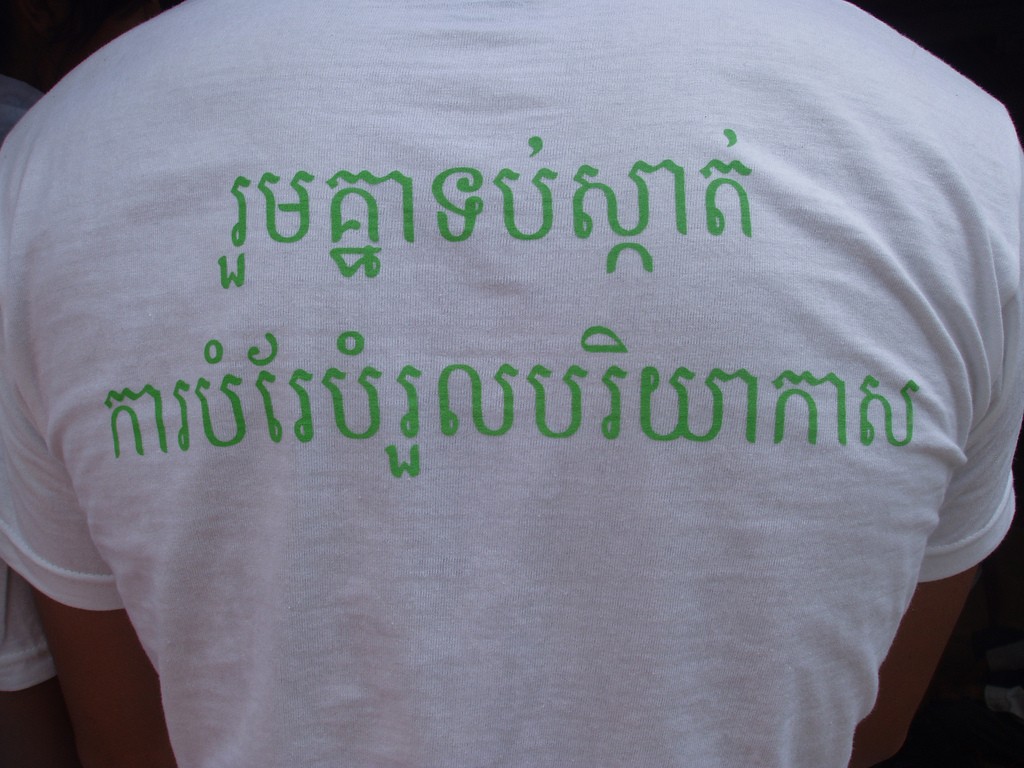
រួមគ្នាទប់ស្កាត់ ការបម្រែបម្រួលបរិយាកាស។ រូបភាព ថតដោយ 350.org, ១២ តុលា ២០១០។ ក្រោមអាជ្ញាប័ណ្ណ CC BY-NC-SA 2.0។
យន្តការការអភិវឌ្ឍស្អាត (CDM)
យន្តការការអភិវឌ្ឍស្អាត (CDM) ដែលបានកំណត់ក្នុងមាត្រា១២ នៃពិធីសារក្យូតូ អនុញ្ញាតឱ្យប្រទេសដែលមានការប្តេជ្ញាចិត្តកាត់បន្ថយ ឬកំណត់ ការបំភាយឧស្ម័ន ដើម្បីអនុវត្តគម្រោងទាំងឡាយណាដែលកាត់បន្ថយការបំភាយឧស្ម័ន នៅក្នុងប្រទេសកំពុងអភិវឌ្ឍន៍។ គម្រោងបែបនេះ អាចរកថវិកាបាន តាមរយៈការលក់ឥណទាន នៃការកាត់បន្ថយការបំភាយឧស្ម័ន (CER) ស្មើនឹងឧស្ម័ន CO2 មួយតោន ដែលអាចត្រូវបានគិតបញ្ចូល ឱ្យត្រូវនឹងគោលដៅនៃពិធីសារក្យូតូ។1
គម្រោង CDM ដែលបានចុះបញ្ជីនៅកម្ពុជា2;3
- គម្រោង Angkor BioCogen: គម្រោងនេះ ផលិតអគ្គិសនីបាន ១.៥ MW តាមរយៈការប្រើប្រាស់អង្កាម ដែលមានទីតាំងស្ថិតក្នុងស្រុកអង្គស្នួល ខេត្តកណ្តាល។ ចំណែកឯការកាត់បន្ថយការបំភាយឧស្ម័នផ្ទះកញ្ចក់ ត្រូវបានប៉ាន់ប្រមាណជាចំនួន ៥១,៦២០ តោននៃកាបូនឌីអុកស៊ីត ក្នុងមួយឆ្នាំ។
- គម្រោងជីវៈឧស្ម័ន ធីធីវ៉ាយ ខេមបូឌា: គម្រោងនេះ បង្កើត និងប្រើថាមពលជីវៈឧស្ម័នដែលកើតឡើងវិញ ដែលមានទីតាំងស្ថិតក្នុងស្រុកមេមត់ ខេត្តកំពង់ចាម។ ចំណែកឯការកាត់បន្ថយការបំភាយឧស្ម័នផ្ទះកញ្ចក់ ត្រូវបានប៉ាន់ប្រមាណជាចំនួន ៥០,០៣៦ តោននៃកាបូនឌីអុកស៊ីតក្នុងមួយឆ្នាំ។
- គម្រោងការផលិតថាមពលពីមេតាន សំរោងធំ: គម្រោងនេះ ផលិតអគ្គិសនីដើម្បីផ្គត់ផ្គង់កសិដ្ឋានចិញ្ចឹមជ្រូក តាមរយៈការប្រើប្រាស់ឧស្ម័នមេតានពីលាមកជ្រូក ដែលមានទីតាំងស្ថិតក្នុងស្រុកកៀនស្វាយ ខេត្តកណ្តាល។ ចំណែកឯ ការកាត់បន្ថយការបំភាយឧស្ម័នផ្ទះកញ្ចក់ ត្រូវបានប៉ាន់ប្រមាណជាចំនួន ៥,៥៩៣ តោននៃកាបូនឌីអុកស៊ីត ក្នុងមួយឆ្នាំ។
- គម្រោងការផលិតថាមពលពីកម្តៅសំណល់ កំពតស៊ីមិន: ការកាត់បន្ថយការបំភាយឧស្ម័នផ្ទះកញ្ចក់ ត្រូវបានប៉ាន់ប្រមាណជាចំនួន ១៧,១០៧ តោននៃកាបូនឌីអុកស៊ីត ក្នុងមួយឆ្នាំ។
- គម្រោងជីវៈឧស្ម័ន នៅក្រុមហ៊ុនចម្រាញ់ជីវៈអេតាណុល MH: គម្រោងនេះ ត្រូវបានអនុវត្តដោយ ក្រុមហ៊ុន MH Bio-Energy Co. Ltd ។ ចំណែកឯការកាត់បន្ថយការបំភាយឧស្ម័នផ្ទះកញ្ចក់ ត្រូវបានប៉ាន់ប្រមាណជាចំនួន ៥៨,១៤៦ តោននៃកាបូនឌីអុកស៊ីត ក្នុងមួយឆ្នាំ។
- គម្រោងជីវៈឧស្ម័ន W2E Siang Phong: គម្រោងនេះ ត្រូវបានអនុវត្តដោយ ក្រុមហ៊ុន W2E Siang Phong Ltd ។ ចំណែកឯការកាត់បន្ថយការបំភាយឧស្ម័នផ្ទះកញ្ចក់ ត្រូវបានប៉ាន់ប្រមាណជាចំនួន ២៦,៥៩២ តោននៃកាបូនឌីអុកស៊ីត ក្នុងមួយឆ្នាំ។
- គម្រោងវារីអគ្គិសនីស្ទឹងឬស្សីជ្រុំក្រោម: ការកាត់បន្ថយការបំភាយឧស្ម័នផ្ទះកញ្ចក់ ត្រូវបានប៉ាន់ប្រមាណជាចំនួន ៧០១,១៩៩ តោននៃកាបូនឌីអុកស៊ីត ក្នុងមួយឆ្នាំ។
- គម្រោងវារីអគ្គិសនីស្ទឹងអាតៃ: គម្រោងនេះ ត្រូវបានអនុវត្តដោយ ក្រុមហ៊ុន C.H.D (Cambodia) Hydropower។ ការកាត់បន្ថយការបំភាយឧស្ម័នផ្ទះកញ្ចក់ ត្រូវបានប៉ាន់ប្រមាណជាចំនួន ២៦៦,៤៧២ តោននៃកាបូនឌីអុកស៊ីត ក្នុងមួយឆ្នាំ។
- គម្រោងវារីអគ្គិសនីស្ទឹងតាតៃៈ គម្រោងនេះ ត្រូវបានអនុវត្តដោយ ក្រុមហ៊ុន ខេមបូឌា តាតៃ ហៃដ្រូផៅវើ អិលធីឌី។ ចំណែកឯការកាត់បន្ថយការបំភាយឧស្ម័នផ្ទះកញ្ចក់ ត្រូវបានប៉ាន់ប្រមាណជាចំនួន ៥៦៣,០៧៤ តោននៃកាបូនឌីអុកស៊ីត ក្នុងមួយឆ្នាំ។
- គម្រោងវារីអគ្គិសនីកំចាយៈ គម្រោងនេះ ត្រូវបានអនុវត្តដោយ ក្រុមហ៊ុន Sinohydro Kamchay Hydroelectric Project Co. Ltd ។ចំណែកឯការកាត់បន្ថយការបំភាយឧស្ម័នផ្ទះកញ្ចក់ ត្រូវបានប៉ាន់ប្រមាណជាចំនួន ២៨១,៣៤៨ តោននៃកាបូនឌីអុកស៊ីត ក្នុងមួយឆ្នាំ។
គម្រោង CDM ទាំងអស់ដែលបានស្នើរឡើងត្រូវតែអនុលោមតាមច្បាប់ស្តីពីការវិនិយោគរបស់ប្រទេសកម្ពុជា។ គម្រោង CDM ទាំងឡាយណាដែលទាក់ទងនឹងថាមពល ត្រូវអនុលោមតាមច្បាប់ស្តីពីអគ្គិសនី រីឯគម្រោង CDM ដែលទាក់ទងនឹងព្រៃឈើ ត្រូវអនុលោមតាមច្បាប់ស្តីពីព្រៃឈើ។
ការកាត់បន្ថយការបញ្ចេញឧស្ម័នពីការកាប់បំផ្លាញព្រៃឈើ និងព្រៃរិចរិល (REDD)
ក្នុងឆ្នាំ ២០១១ កម្ពុជាបានទទួលការផ្តល់ថវិកាពេញលេញ លើកម្មវិធីផ្តួចផ្តើមសម្រាប់ការកាត់បន្ថយការបំភាយឧស្ម័ន ពីការបាត់បង់និងការរិចរិលព្រៃឈើ របស់អង្គការសហប្រជាជាតិ (UN-REDD)។ មុនពេលមានកម្មវិធីនេះ កម្ពុជាបានរៀបចំកម្មវិធីការត្រៀមផែនទីបង្ហាញផ្លូវរ៉េដបូក រួចទៅហើយ។ កម្មវិធីថ្នាក់ជាតិ ផ្តោតលើការគ្រប់គ្រងប្រកបដោយប្រសិទ្ធភាព នៃដំណើរការរ៉េដបូក និងការចូលរួមរបស់ភាគីពាក់ព័ន្ធ ការអភិវឌ្ឍនិងក្របខណ្ឌយុទ្ធសាស្ត្រនិងការអនុវត្តរ៉េដបូកថ្នាក់ជាតិ ការបង្កើនសមត្ថភាព ដើម្បីគ្រប់គ្រងកម្មវិធីរ៉េដបូក នៅថ្នាក់ក្រោមជាតិ និងការរចនាប្រព័ន្ធត្រួតពិនិត្យ។4
ផែនការនេះ មានគោលបំណងស្វែងរកក្រុមហ៊ុនបរទេសទាំងឡាយណា ដែលចង់ទូទាត់ការបញ្ចេញកាបូនរបស់ពួកគេ ដោយចំណាយថវិកាមកកម្ពុជាសម្រាប់ការរអភិរក្សព្រៃឈើ។ ក្នុងរយៈពេលជាង ៣០ ឆ្នាំមក គម្រោងនេះ អាចមានសក្តានុពលរកប្រាក់ចំណូលបានរាប់លានដុល្លារ ដើម្បីបែងចែករវាងរដ្ឋ និងសហគមន៍ក្នុងតំបន់។
គម្រោងសាកល្បងរ៉េដបូកចំនួនពីរ ដែលគម្រោងមួយស្ថិតនៅក្នុងខេត្តឧត្តរមានជ័យ និងគម្រោងមួយទៀតស្ថិតនៅក្នុងខេត្តមណ្ឌលគិរី ត្រូវបានបង្កើតឡើងសម្រាប់ទីផ្សារកាបូនស្ម័គ្រចិត្ត។ក្នុងនោះផងដែរ រដ្ឋបាលព្រៃឈើនៃក្រសួងកសិកម្ម ទទួលបន្ទុកការវាយតម្លៃកាបូនស្តុកក្នុងព្រៃឈើថ្នាក់ជាតិ និងការគ្រប់គ្រងពាណិជ្ជកម្មកាបូនព្រៃឈើ។5 បន្ទាប់ពីកិច្ចខិតខំប្រឹងប្រែងអស់រយៈពេលជាច្រើនឆ្នាំ កម្មវិធីនេះ បានជួបការលំបាក ដោយមូលហេតុថា មកទល់នឹងឆ្នាំ២០១៤ មិនទាន់មានក្រុមហ៊ុនណាមួយបានចូលរួមក្នុងគម្រោងនេះនៅឡើយទេ។6
ការផ្តួចផ្តើមគំនិតថ្នាក់តំបន់
អនុសាសន៍ដើម្បីកាត់បន្ថយផលប៉ះពាល់នៃការប្រែប្រួលអាកាសធាតុដែលមាននៅក្នុង Bangkok Call for Action ត្រូវបានបង្កើតឡើងក្នុងកិច្ចពិភាក្សាប្រសិទ្ធិភាពនៃជំនួយនិងហិរញ្ញវត្ថុការប្រែប្រួល អាកាសធាតុនៅតំបន់អាស៊ីប៉ាស៊ីហ្វិក ធ្វើនៅថ្ងៃទី ១៩-២០ ខែតុលា ឆ្នាំ២០១០ នៅទីក្រុងបាងកក។ កិច្ចពិភាក្សានេះ ត្រូវបានសម្របសម្រួលដោយ អង្គការការអភិវឌ្ឍសមត្ថភាពសម្រាប់ប្រសិទ្ធភាព នៃការអភិវឌ្ឍ (CDDE) និងបានអញ្ជើញអ្នកចូលរួមជាង ៧៥ នាក់ ដែលជាតំណាងឱ្យរដ្ឋាភិបាលនៃប្រទេស បង់ក្លាដែស កម្ពុជា ឡាវ នេប៉ាល់ ឥណ្ឌូនេស៊ី ហ្វីលីពីននិងវៀតណាម ព្រមទាំងលេខាធិការដ្ឋានវេទិកា កោះប៉ាស៊ីហ្វិក ដៃគូអភិវឌ្ឍន៍និងទីភ្នាក់ងារអន្តរជាតិចំនួន ៨។7
ធ្វើបច្ចុប្បន្នភាពចុងក្រោយ៖ ១៧ វិច្ឆិកា ២០១៥
ឯកសារយោង
- 1. “យន្តការការអភិវឌ្ឍស្អាត (CDM).” អនុសញ្ញាក្របខណ្ឌសហប្រជាជាតិស្តីពីការប្រែប្រួលអាកាសធាតុ. http://unfccc.int/kyoto_protocol/mechanisms/clean_development_mechanism/items/2718.php
- 2. “ខិត្តប័ណ្ណយន្តការទីផ្សារថ្នាក់ជាតិ៖ ប្រទេសកម្ពុជា.” វិទ្យាស្ថានយុទ្ធសាស្រ្តបរិស្ថានជាសាកល. ដកស្រង់ ១ កក្កដា ២០១៥. http://pub.iges.or.jp/modules/envirolib/upload/984/attach/cambodia_final.pdf.
- 3. វិទ្យាស្ថានយុទ្ធសាស្រ្តបរិស្ថានជាសាកល (IGES), សំណុំទិន្នន័យគម្រោង CDM (គិតត្រឹម ៣១ មករា ២០១៥). ដកស្រង់ ១ កក្កដា ២០១៥. http://www.iges.or.jp/en/climate-energy/mm/publication.html#03.
- 4. “ប្រទេសកម្ពុជា.” កម្មវិធី UN-REDD. ដកស្រង់ ១០ កញ្ញា ២០១៤. http://www.un-redd.org/AboutUNREDDProgramme/NationalProgrammes/Cambodia/tabid/6896/Default.aspx
- 5. ការរៀបចំត្រៀមផែនការកម្មវិធីរ៉េដបូក នៅរដ្ឋបាលព្រៃឈើនៃក្រសួងកសិកម្មរុក្ខាប្រមាញ់និងនេសាទ. កិច្ចប្រជុំក្នុងការផ្លាស់ប្តូរព័ត៌មានរវាងក្រុមកម្មវិធី UN-REDD ថ្នាក់តំបន់ នៅទីក្រុងបាងកក, ៨-១០ វិច្ឆិកា ២០១០. http://www.unredd.net/index.php?option=com_docman&task=cat_view&gid=2419&Itemid=53.
- 6. គុជ ណារ៉េន និង Zsombor Peter. “ខណៈពេលព្រៃឈើកំពុងធ្លាក់ចុះ ផែនការឥណទានកាបូនមានបញ្ហាប្រឈម.” កាសែតខេមបូឌាដេលី, ២៩ ឧសភា ២០១៤. https://opendevelopmentcambodia.net/news/as-forests-fall-carbon-credit-plan-faces-collapse/.
- 7. The Bangkok Call for Action, ២៨ តុលា ២០១០.https://www.climatefinance-developmenteffectiveness.org/sites/default/files/bangkokCallForAction.pdf

